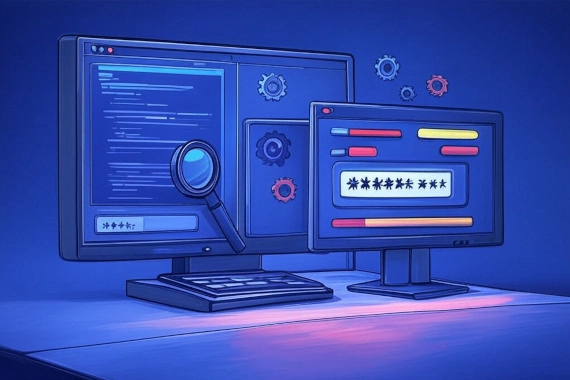
Top 10 Cyber Threat Monitoring Tools Every Security Team Needs
Dark Web Monitoring Threat Intelligence Best Practices
What is a Cyber Threat Monitoring Tool? A cyber threat monitoring tool alerts security teams to potential threats before …

FACT: 20% of cyber attacks exploited vulnerabilities last year (Verizon DBIR).
In particular, zero-day exploits targeting edge devices and VPNs have increased 34%.
Having said that, credential theft is still the primary initial attack vector threat actor exploit at 22%.
Without proper intelligence about which vulnerabilities are being actively exploited or which employee or customer credentials have leaked, security teams are essentially operating blind.
Trying to defend everything equally rather than focusing on the most likely threats is a surefire way to fail.
Effective threat intelligence management transforms disparate security data into actionable insights that drive priorities.
In this post, we’ll cover practical tips to building an effective threat intelligence program.
But first, let’s define what threat intelligence management means.
Threat intelligence management enables companies to understand their threat landscape, identify potential vulnerabilities, and prioritize patching.
Threat intelligence management also helps organizations analyze attackers’ tactics, techniques, and procedures (TTPs) to improve detection capabilities.
By incorporating both internal security data and external threat feeds, companies can better identify which assets are most at risk and deploy resources more strategically to protect their critical infrastructure.
In addition, by continuously monitoring the dark web for credentials and company mentions, organizations can proactively address potential issues before they escalate.
Having actionable insights about threats facing your organization provides several benefits.
The average dwell time of an attacker on a network before they’re discovered is 24 days.
By understanding the TTPs attackers use, organizations can implement more effective detection rules and monitoring systems.
This enables faster identification of suspicious activities and more effective incident response.
In terms of preventing attacks, threat intelligence can be used to understand which vulnerabilities are actively being exploited in the wild.
This helps teams prioritize remediation efforts and allocate resources.
Another benefit is in monitoring third-party suppliers.
Data breaches caused by third parties have doubled over the last year to 30% of all data breaches.
Threat intelligence helps organizations better assess the security of their vendors and service providers.
This enables more effective due diligence and continuous monitoring of the organization’s supply chain.
However, to realize these benefits, organizations need a structured approach to threat intelligence.
There are five key stages of the threat intelligence lifecycle that form the foundation of an effective program.
Threat intelligence typically follows a five-stage lifecycle:
During the initial stage, organizations define their requirements and objectives with threat intelligence. Security teams determine what specific information they need to protect their assets, which threats are most relevant to their industry, and what decisions will be informed by the intelligence gathered. Essentially, this stage establishes the focus and scope of the threat intelligence program.
During this stage, organizations gather raw data from multiple sources that might contain relevant threat information. These sources typically include:
The collected raw data is processed, structured, and normalized into a usable format. This often involves:
This is the stage where processed data is transformed into actual intelligence. Analysts evaluate the information, identify patterns, determine relevance to the organization, and create intelligence products such as:
The final stage involves sharing the finished intelligence with the appropriate stakeholders in formats that are useful for their specific needs. This might include:
This stage also includes collecting feedback from the intelligence consumers to refine the process and adjust intelligence requirements. This creates a continuous improvement loop that feeds back into the planning stage.
While understanding the process is crucial, it’s equally important to understand the different types of threat intelligence and the purposes they serve.
Cyber Threat Intelligence can be divided into three distinct types. Each type serves a different purpose and audience within an organization:
Strategic intelligence focuses on high-level information about the threat landscape that informs executive decision-making and security strategy. It addresses:
This type of intelligence is primarily used by executives, boards of directors, and senior security leaders who need to understand the big picture without technical details. It typically takes the form of briefings, reports, and risk assessments written in business language rather than technical terms.
Tactical intelligence provides information about attackers’ tactics, techniques, and procedures (TTPs). It helps security teams understand:
This intelligence is used by security managers, architects, and defenders. Its goal is to design security controls, update defense strategies, and prioritize security initiatives. It bridges the gap between high-level strategy and day-to-day operations.
Operational intelligence (sometimes called technical intelligence) consists of specific technical indicators and actionable data that can be implemented in security tools. This includes:
This type of intelligence is consumed by security operations teams, incident responders, and security tools that can automatically implement detection and blocking based on these indicators.
Each type of intelligence serves a different purpose. A comprehensive threat intelligence program should incorporate all three types to ensure that intelligence flows to the right stakeholders in formats that meet their specific needs.
As organizations implement these different types of intelligence, it’s important to understand how threat intelligence complements and differs from other security functions. One common point of confusion is the relationship between CTI and vulnerability management.
Cyber Threat Intelligence and vulnerability management are two essential security practices that work together but serve different purposes.
Threat intelligence focuses on understanding who might attack you, how they operate, and what they’re targeting.
It’s like keeping track of who are the criminals in your neighborhood and their typical methods for breaking into houses.
Vulnerability management, on the other hand, is focused on finding and fixing weaknesses in your own systems before attackers exploit them.
This is similar to checking your home for unlocked doors and broken windows.
Both practices work best when combined.
Threat intelligence helps you prioritize which vulnerabilities to fix first by telling you which weaknesses attackers are actively exploiting.
Now that we’ve discussed what threat intelligence is (and isn’t), let’s talk about some practical approaches to implementing an effective threat intelligence program.
Here are some suggestions when implementing a threat intelligence program in your organization:
Start by identifying what specific information your organization needs most. This might include threats targeting your industry, vulnerabilities in the technologies you use, or tactics commonly employed against businesses your size. Having clear requirements helps focus your efforts on gathering the most relevant intelligence.
Don’t rely on just one source of threat information. Use a combination of commercial threat feeds, open-source intelligence, industry sharing groups, security vendor reports, and your own internal security data. This provides a more complete picture of the threat landscape.
Develop a consistent method for collecting, analyzing, and distributing intelligence throughout your organization. This might include regular intelligence briefings, standardized reporting formats, and clear procedures for escalating critical threats.
Prioritize intelligence that can be directly converted into security actions. This includes specific credentials that need to be reset, indicators of compromise (like malicious IP addresses or file hashes), or detailed attack methods. The intelligence should include recommendations for how to remediate the threat.
Connect your threat intelligence with your existing security tools like firewalls, endpoint protection, and SIEM systems. This allows for automated blocking of known threats and faster detection of suspicious activities based on current intelligence.
Regularly review how threat intelligence is being used and what value it’s providing. Collect feedback from security teams about which intelligence was most helpful and adjust your approach based on this information.
Ensure the right information reaches the right people in formats they can use. Technical teams need detailed indicators, security managers need tactical insights about attack methods, and executives need strategic summaries of major threats.
Implementing these suggestions requires expertise, dedicated resources, and the right tools. While building an in-house threat intelligence capability is valuable, many organizations benefit from partnering with specialized providers to accelerate their capabilities.
Breachsense helps organizations secure their employees identities, prevent ransomware, and prevent account takeovers due to compromised credentials and third-party breaches. Breachsense transform how organizations manage cyber threats with comprehensive, highly actionable intelligence. Book a demo to learn how we can help prevent your next attack.

Dark Web Monitoring Threat Intelligence Best Practices
What is a Cyber Threat Monitoring Tool? A cyber threat monitoring tool alerts security teams to potential threats before …

Dark Web Monitoring Threat Intelligence Best Practices
What Are Threat Intelligence Tools? Threat intelligence tools provide security teams with information about potential or …